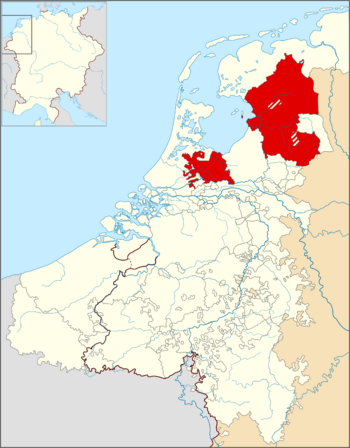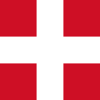Prince-Bishopric of Utrecht facts for kids
Quick facts for kids
Prince-Bishopric of Utrecht
Sticht Utrecht (Dutch)
|
|||||||||||
|---|---|---|---|---|---|---|---|---|---|---|---|
| 1024–1528 | |||||||||||

Bishopric of Utrecht c. 1350. Nedersticht is the smaller territory while Oversticht is the larger territory.
|
|||||||||||
| Status | State of the Holy Roman Empire | ||||||||||
| Capital | Utrecht | ||||||||||
| Common languages | Middle Dutch, Middle Low German | ||||||||||
| Religion | Roman Catholicism (State religion) | ||||||||||
| Government | Ecclesiastical principality | ||||||||||
| Prince-bishop | |||||||||||
|
• (1024–1026)
|
Adalbold II of Utrecht | ||||||||||
|
• (1524–1528)
|
Henry of the Palatinate | ||||||||||
| Historical era | Middle Ages | ||||||||||
|
• Lower Lotharingia divided from Lotharingia
|
959 | ||||||||||
|
• Established
|
1024 | ||||||||||
| 1075–1122 | |||||||||||
| 1122 | |||||||||||
|
• Joined the Burgundian Circle
|
1512 | ||||||||||
|
• Guelders Wars
|
1502–1543 | ||||||||||
|
• Disestablished
|
1528 | ||||||||||
|
• Union of Utrecht signed
|
1579 | ||||||||||
|
|||||||||||
| Today part of | Netherlands | ||||||||||
The Prince-Bishopric of Utrecht (called Sticht Utrecht in Dutch) was a special kind of state. It was part of the Holy Roman Empire in a region now known as the Netherlands. From 1024 to 1528, it was ruled by the bishops of Utrecht.
This Prince-Bishopric was different from the larger Diocese of Utrecht. The Diocese was about the bishop's religious power. The Prince-Bishopric was about the bishop's power as a ruler over land. Outside the Prince-Bishopric, the bishop only had religious authority.
In 1528, Charles V, Holy Roman Emperor took away the bishop's power to rule the land. This made the Prince-Bishopric no longer a separate state.
Contents
What Was the Prince-Bishopric of Utrecht?
The Prince-Bishopric of Utrecht was a territory governed by a prince-bishop. A prince-bishop was a bishop who also acted as a secular ruler. This means they had both religious and political power. They were like a king or a duke, but also a religious leader.
The Holy Roman Empire was a large group of lands in Central Europe. It existed for over 1,000 years. The Prince-Bishopric was one of its many smaller states.
How It Started: The Diocese of Utrecht
The story of Utrecht's bishops began in 695 AD. A missionary named Saint Willibrord became the first bishop for the Frisian people. He settled in an old Roman fort in Utrecht.
After Willibrord, the area faced many attacks. But things got better under the Saxon emperors. These emperors often invited the bishops of Utrecht to important meetings.
Becoming a Prince-Bishopric
In 1024, something big happened. The bishops of Utrecht were given the title of "Princes of the Holy Roman Empire". This meant they gained political power over a territory. This new state was called the Prince-Bishopric of Utrecht.
The land they ruled was known as Sticht Utrecht or Het Sticht. This territory was split into two main parts:
- The Nedersticht (Lower Sticht): This area is similar to the modern province of Utrecht.
- The Oversticht (Upper Sticht): This included areas like today's Overijssel, Drenthe, and part of Groningen.
Who Chose the Bishop?
At first, the Emperor had a lot of say in choosing the bishop. But in 1122, a deal called the Concordat of Worms changed things. The Emperor lost his right to choose. Instead, the cathedral chapter (a group of priests) got to elect the bishop.
However, this right was soon shared with other church groups in the city. Also, powerful neighbors, like the Counts of Holland and Guelders, wanted to influence the choice. This often led to disagreements. Sometimes, the Pope himself had to step in and choose the bishop directly.
Joining New Groups
The Prince-Bishopric was part of a larger group called the Lower Rhenish–Westphalian Circle. Later, in 1548, it joined the Burgundian Circle. This was part of the Habsburg Netherlands.
The End of the Prince-Bishopric
In 1527, the bishop decided to sell his lands and his power to Emperor Charles V. This made the Prince-Bishopric a direct part of the Habsburg lands. The church groups gave up their right to elect the bishop to Charles V. The Pope agreed to this under political pressure.
How It Ended
The Prince-Bishopric of Utrecht was fully taken over by Habsburg troops in 1528. The main part of the territory around Utrecht city became the Lordship of Utrecht. The southern part of the Oversticht became the Lordship of Overijssel. The northern parts were taken over in 1536 and became the County of Drenthe.
Important Prince-Bishops
- Adalbold II (1010–1026)
- Bernold (1026/7–1054)
- William I (1054–1076)
- Conrad (1076–1099)
- Burchard (1100–1112)
- Godbald (1114–1127)
- Andreas van Cuijk (1127/8–1139)
- Hartbert (1139–1150)
- Herman van Horne (1151–1156)
- Godfrey van Rhenen (1156–1178)
- Baldwin II van Holland (1178–1196)
- Arnold I van Isenburg (1196–1197)
- Dirk I van Holland (1197)
- Dirk II van Are (van Ahr) (1197/8–1212)
- Otto I van Gelre (1212–1215)
- Otto II van Lippe (1216–1227)
- Wilbrand van Oldenburg (1227–1233)
- Otto III van Holland (1233–1249)
- Gozewijn van Amstel (van Randerath) (1249–1250)
- Henry I van Vianden (1250/2–1267)
- John I of Nassau (1267–1290)
- John II van Sierck (1290–1296)
- Willem II Berthout (1296–1301)
- Guy van Avennes (1301–1317)
- Frederik II van Sierck (1317–1322)
- Jacob van Oudshoorn (1322)
- Jan III van Diest (1322–1340)
- Jan IV van Arkel (1342–1364)
- Jan V van Virneburg (1364–1371)
- Arnold II of Horne (1371–1379)
- Floris van Wevelinkhoven (1379–1393)
- Frederik III van Blankenheim (1393–1423)
- Rudolf van Diepholt (1423–1455)
- Zweder van Culemborg (1425–1433)
- Walraven van Meurs (1434–1448)
- Gijsbrecht van Brederode (1455–1456)
- David of Burgundy (1456–1496)
- Frederick IV of Baden (1496–1517)
- Philip of Burgundy (1517–1524)
- Henry of the Palatinate (1524–1529)



